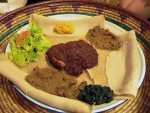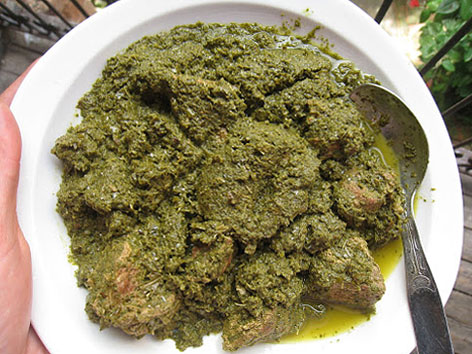
We never said ravitoto was pretty (credit).
Though relatively unknown in the West, cassava, also called manioc or yucca, has long been an important staple food throughout much of Africa (and elsewhere), including Madagascar and the rest of the sub-Saharan region, showing up in restaurants and markets, and on family’s tables, nearly as often as french fries in the U.S. (see also: cassava leaf stew in Sierra Leone). Widespread as it is, however, this potato-like tuber is nothing special in a culinary sense: It has a starchy, slightly bitter taste and, if not prepared correctly, contains traces of cyanide. So why on Earth would so many people eat this plant?
Cassava’s many personalities
For starters, cassava is incredibly resilient in poor soil conditions and low rainfall, making it an easy-to-grow source of carbohydrates in subtropical climates. In a sense, this characteristic has given cassava a bad reputation as a “poor man’s food”—the food you eat when there’s nothing else around, since even in the worst harvest seasons there’s likely still cassava to be found. But it’s not viewed exclusively that way in Madagascar.
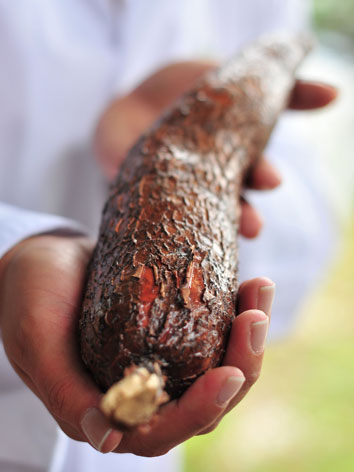
Cassava root. Photo: Ciat
Here, cassava (known as mangahazo) takes on many guises. In its purest form, there’s cassava root, often spotted in little pyramids in Malagasy markets, uncooked and ready for purchase. You’ll know them by their rough, brown, bark-like skin and long tapered shape. In more creative displays, you’ll see samples sliced in half, showing off the smooth, white insides.
Outside the markets, however, you’ll encounter this same root peeled, boiled, and salted at street-side food stalls, peddled as a cheap snack for passersby and schoolkids. Less visibly, you’ll see cassava pounded up and turned into flour (koba mangahazo), then used to bake small, circular breads. Often sold for a few cents alongside coffee, these soft, squishy breads make a cheap and filling (though not terribly nutritious) breakfast. If you’re really in the know, you can follow the pungent scent of bononoka, or fermented cassava. Typically sold out of large, metal vats in the markets, this version of cassava tastes like it smells—strong and sour. It’s not for the fainthearted.
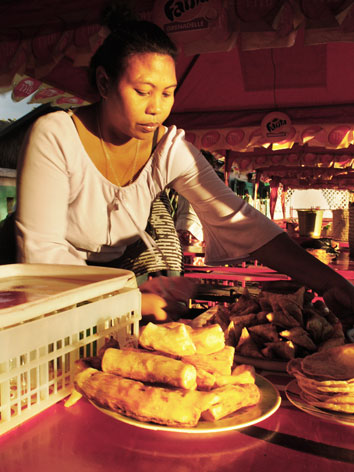
Cassava vendor. Photo: Jessie Beck
For the most part, the root of this plant isn’t considered a full meal, but a snack, or an ingredient in a snack. However, it’s a dish made from the bright green leaves of this tuber, ravitoto (“rahv-ee-tu-tu”), that always evokes the happiest and most powerful memories of food for Malagasy.
Ravitoto: pure comfort food
Nationwide, this traditional dish is made by boiling pounded cassava leaves, oil, and meat over a charcoal fire, and served (like everything in Madagascar) alongside a heaping bowl of rice. There are some regional variations—beef replaces pork in more Muslim-dominated regions, coconut milk is added in coastal areas, occasionally peanuts are included. But “how ravitoto is prepared depends more on the family,” says Gaelle, a college student in Antananarivo. This traditional dish not only represents a national cuisine, but it’s also synonymous with home-cooked comfort food.
For me, I first found comfort in ravitoto when a friend and I got caught in a tropical downpour on Ile Sainte Marie, Madagascar. We ducked for cover at an airy restaurant, where a lone server sat on a grass mat over a large basket of leaves. She said she was cooking ravitoto. “Can we help?” we asked, now hungry and considering that the promise of ravitoto in a rainstorm sounded pretty good.
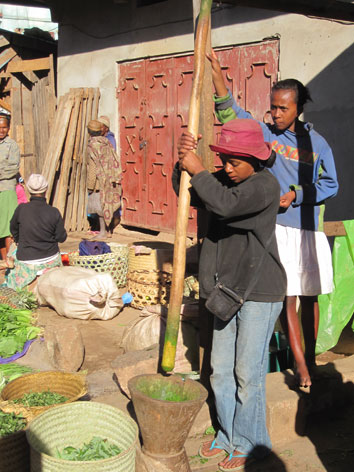
Pounding cassava for ravitoto. Photo: NH53
As the rain filled buckets outside (literally), we sat with our new friend, plucking the cassava leaves off their branches and chatting about the weather. We watched her toss the leaves into a large mortar and pestle and pound until the leaves looked minced and pulpy, almost like wet grass cuttings. Finally, she disappeared into her kitchen to boil the leafy mass together with fatty chunks of pork, oil, and coconut milk—we were, after all, on the coast.
About an hour later, we finally settled down to a steaming-hot plate of ravitoto, which at this point looked a lotlike wet grass clippings, with rice. It had a savory and distinctly earthy flavor that was, admittedly, a little weird. More unique was the texture: Although the oiliness of the pork kept the leaves moist, the dish managed to retain a slight grittiness that got stuck between our teeth. When spooned on top of rice, the dish was a dance of textures: gritty leaves, tender meat, al dente rice.
Especially with the added flavor of the coconut milk, we couldn’t get over how simple yet satisfying ravitoto was on that rainy afternoon. Both of us knew this dish; we already liked it. Yet as foreigners, we lacked the same association of ravitoto with comfort food as Malagasy. For us, it was tasty and unusual, but for Malagasy it was a dish they came home to, a dish mothers and wives lovingly prepared, and a dish that, despite regional and tribal differences, the entire nation could agree on loving. On that afternoon, eating home-cooked ravitoto, we finally understood.
.jpg)
Credit here
Where to try ravitoto in Madagascar
While we highly recommend befriending a Malagasy while you’re there and hinting that you want to try ravitoto (without a doubt, they’ll excitedly invite you over so they or their mom/sister/wife can cook you a pot), here are a few restaurants in various cities that’ll whip up some for you—just like mom used to make.
Mahajanga
Near the Lycee Philibert Tsiranana, try Resto Gasy, a basic Malagasy eatery specializing in local cuisine.
Antananarivo
A boutique hotel and expat hot spot, Sakamanga (Ampasamadinika, Lalana Adrianary Ratianarivo) deals in French-Malagasy fusion. Come early on Fridays and Saturdays when the place is packed! Or try the basic restaurant inside Radama Hotel (22 Ave. General Ramanantsoa, Isoraka).
Antsirabe
You should be able to find this dish at lively Chez Billy (Rue Daniel Rakondrainibe, Lot 01 C 1 Antsenakely, Rue De La Myre De Villers) or Zandina Cafe (5, rue du Marechal Joffre, Cercle Mess).
Morondava
Both Hotel Trecicogne (Bp 243, Nosy Kely) and popular Le Sun Beach Hotel are good bets.
Ile Sainte Marie
Try the restaurant inside pretty Eco-lodge Ravohara.
In a smaller town? Just ask a local hotely (small, Malagasy eatery) in advance to prepare you some!
About the author: Originally from Washington D.C., Jessie Beck has followed her love of travel across the globe to Malta, Costa Rica, Seattle, and most recently Madagascar as a Peace Corps volunteer. When not biking or sampling local cuisine, she blogs about life as a nomad at beatnomad.com.










.jpg)
